|
Almaty is the largest city of Kazakhstan. Wordbuilding of nouns and adjectives. |
|||||
|
Parts of the lesson |
Time |
Content |
Teacher’s action of management |
Cognitive action of students |
Visual aids, resources |
|
Introduction |
7 мин |
І part 1. Organization moment: greeting the students. 2.Dividing the group into groups. 3. Checking-up homework |
1.Good morning! How are you? 2. Divides students. 3. Now, let’s check your home task. What was your home task for today? Let’s check, who is ready? Who wants? |
-Good morning Teacher! We are fine! Group: 1 and 2 It was retell the text |
stick papers |
|
Presentation of the lesson |
5 мин |
ІІ part Creation the language atmosphere |
— What is the weather like today? -What season is it now? -Is it raining today? |
Answer the questions |
slide |
|
Main part |
15 мин |
ІІІ part Listening and Reading Work group |
Read the text “Almaty city” Writing new words |
Read and translate, then talk your partner or group, then to write new words |
slide dictiona-ry tasks |
|
10 мин |
ІV part Grammar: Wordbuilding of nouns and adjectives. Writing |
-Explain rule with examples — to give out tasks on grammar |
Work in pairs Do tasks |
handout |
|
|
Conclusion |
5 мин |
V part Concluding the lesson. Speaking |
Look at the pictures on slide and answer |
Answer the questions |
slide |
|
Evaluation |
1 мин |
VІ part Evaluating by criteria of assessment. |
Puts summative assessment |
Give each other smiles and say their opinions. -The leader student evaluates the group |
|
|
Home assignment |
1 мин |
Answer the questions |
Explain homework. |
Writing home task. |
copy book |
|
Reflection of the lesson |
1 мин |
2 stars, 1 offer. |
I like …………… During a lesson …… |
ҚАЗАҚСТАН РЕСПУБЛИКАСЫ БІЛІМ ЖӘНЕ ҒЫЛЫМ МИНИСТРЛІГІ
«Бақанас аграрлы – индустриалдық колледжі» МКҚК
САБАҚ ЖОСПАРЫ
|
Келісілді Директордың оқу-ісі жөніндегі орынбасары Каркынбаева Г.О. _____________ «____» ________________ 2017ж. |
Модульдің / пәннің атауы: шетел тілі Дайындаған: Рақымберлі Ж.Р Оқытушы: Рақымберлі Ж.Р |
|||
|
1 курс 12 топ |
Күні |
Сабақ нөмірі |
Мамандық Біліктілік: |
0508000 – «Тамақтандыруды ұйымдастыру» 0508012 – «Аспаз» |
|
№ |
||||
|
1 курс 13 топ |
Күні |
Сабақ нөмірі |
Мамандық Біліктілік: |
1201000 –« Автомобиль көлігіне қызмет көрсету, жөндеу және пайдалану» 1201072 – «Автокөліктерді жөндеуші слесары» |
|
№ |
||||
|
Пән/модуль атауы: |
Шетел тілі |
|||
|
Сабақ тақырыбы: |
Almaty is the largest city of Kazakhstan. Wordbuilding of nouns and adjectives. |
|||
|
Ұзақтығы: |
45 мин. |
|||
|
Өткізу орны: |
Шет тілі кабинеті |
|||
|
Сабақ мақсаты: |
Студенттерге тақырып бойынша мәлімет беру. |
|||
|
Сабақ міндеттері: |
Білімділік: Студенттердің тақырыпқа сай сөздік қорын молайту, еркін сөйлеуге, сөздің дұрыс дыбысталуын жетілдіру, грамматикалық ережелерді дұрыс қолдану. Дамытушылық: Ойлау қабілетін дамыту, жазу, сөйлеу, оқу арқылы өз ойын еркін айтуды арттыру. Тәрбиелік: Елін, отанын сүйге, патриот болуға, еңбекке жауапкершілікпен қарауға тәрбиелеу; тәртіптілікке баулу. |
|||
|
Күтілетін нәтиже: |
Тақырыпты меңгеруі |
|||
|
Сабақ типі |
Аралас сабақ |
|||
|
Оқыту әдістері, педагогикалық техникалар, педагогикалық технологиялар: |
||||
|
Миға шабуыл; топтастыру; академиялық дау – дамай әдісі; ыстық орындық; кім жылдам; АКТ; оқыту мен оқудағы жаңа тәсілдер; оқыту үшін бағалау және оқуды бағалау; сыни тұрғыдан ойлауға үйрету; оқытуды басқару және көшбасшылық; |
||||
|
Қажетті құралдар мен жабдықтар: |
Сөздік, карта, кесте, слайд, оқулық, экран, проектр, флипчарт, маркерлер, портреттер, тақта, бор, стикерлер, таратпа қағаздар , CD диск |
|||
|
Қосымша ақпарат көзі (әдебиет): |
«English» Т. Аяпова, З. Әбілдаева, Ж. Тұтбаева, З. Садуақасова, Ж. Құрмамбаева; Таратпа қағаздар; |
|||
|
Оқытушы жайлы байланыс ақпарат: |
||||
|
Рақымберлі Жансулу Рақымберліқызы |
Тел: 87475960196 Е-mail: zhansulu.rjan.r@mail.ru |
Almaty City
Almaty is the largest financial, economic and cultural city of Kazakhstan. Almaty was the capital of Kazakhstan from 1929 to 1997. It is one of the most beautiful cities in Kazakhcstan with a population of of 1,348,500 (as of 1 September 2008), which represents 9% of the population of the country, situated in the foothills of the ZailiskyAlatau Mountains. It accommodates numerous business centers, theaters, museums, art galleries, exhibition halls and countless modern entertainment complexes. The name “Almaty” derives from the Kazakh word for “apple” (alma), by which the surrounding region is rich; the region that is thought to be the ancestral home of the apple, and the wild Malussieversii, is considered a likely candidate for the ancestor of the modern domestic apple.
Residents and guests of the southern capital have at their disposal 5 stadiums, a hippodrome, and the high-altitude Medeo sport complex, featuring a unique ice skating rink located at 1700 m above sea level.
This is where world records have been set many times by the world’s top skaters. Medeo is a popular skating area for residents and guests of Almaty. Almaty Central Stadium accommodates 32,000 people. Nearby is a venue for track and field athletes and a perfectly equipped winter swimming pool.
Mountainous areas the visiting card of Almaty. You can begin your acquaintance with them on a ride by cable car to the city’s highest point, Kok-Tyobe (Blue Hill), 1130 m above sea level.
From here you can view a splendid panorama of the mountain ranges and the city. It is especially beautiful at night when Almaty is illuminated by glimmering lights. The cableway soars over the old part of the city, buried in gardens called Compote by locals. This area is so called because of the fruit names of streets located here: Cherry, Pear, Grape, etc. While riding the cablecar up the hill you can watch the lifestyle of local people almost as in an ethnographic museum. The Kok-Tyube hillside is topped by a350 m TV tower. It’s built in a seismically active area.
The new 2030 General Plan of Almaty was developed in 1998 and aims at forming ecologically safe, secure and socially comfortable living conditions. The main objective is to promote Almaty’s image as a garden-city. One of the components of the General Plan is to continue multi-stored and individual construction, reorganize industrial territories, improve transport infrastructure and launch Almaty Metro (Almaty Subway). At the same time, some officials and Almaty city dwellers actively opposed metropolitan construction in seismically active zone. Some scientists said that in case of strong earthquake, the city will immediately fall under ground. However, constructors state that metropolitan is constructed taking in consideration Almaty city seismic situation. In fact, metropolitan construction started in 1989, hardly any of the project initiators could suppose that construction time would have lasted for 20 years. The total length of Almaty metropolitan is planned to be equal to 45 kilometers.
Saint-Voznesenskiy is an Orthodox Cathedral designed by the local architect A. Zenkov, was built without the use of any nails in 1940 and is one of the nine most unique wooden buildings in the world. Its wall paintings and interior decoration boggle the imagination of the visitors with its beauty and magnificence. The remarkable fact is that the Cathedral outstood a very strong earthquake of 9 points by Richter scale in 1911.
It is an inimitable construction that decorates the Republic Square. It was erected by a creative group under the supervision of Shota Valikhanov. This god-like image floats in the glaring sky of the Southern capital while the “Golden” Man tames the snow leopard. Around this monument there is the history of the ancient Kazakh land. Original of the Golden Man artifacts said to be kept in Kazakhstan President Nazarbayev’s presidential palace.
Central (Gorky) Park
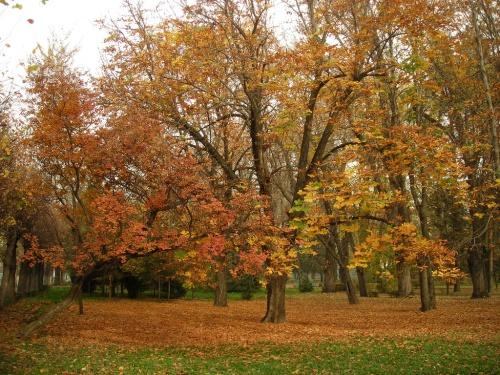
Almaty’s biggest recreational area (admission 25T; 24hr), at the eastern end of Gogol, is still known as Gorky Park. It has lakes, funfair rides, an Aquapark (Jun-Sep), a zoo, and several cafés, and shashlyk stands.
Some lovely species at Gorky Park zoo

There are many museums in Almaty worth to visit like the uniquely Museum of Kazakh musical Instruments, Geology Museum, there displayed the country’s mineral wealth, city’s best Central State Museum, that takes you through Kazakhstan’s history from bronze-age burial mounds to telecommunications and the transfer of the capital to Astana, with more than 200,000 beautiful artifacts. The first exhibit hall has historical costumes including replica of Golden Man, while other exhibits include clothing, objects and even a yurt!
: Grammar. The Articles. Almaty is the largest city of Kazakhstan. Word order. Word buildings of Nouns and Adjectives.
Материал жайлы қысқаша түсінік:
Жаңа грамматикалық тақырыпты түсіндіре отырып, ағылшын тілін терең меңгертуге үйрету.
Төмендегі Барлығы толық нұсқасы емес, тек сізге танысу үшін көрсетілген, сайтқа жарияланған документтен айырмашылығы болуы мүмкін. Жүктеу үшін осы беттің төменгі жағындағы жүктеу деген жазуды басу керек

: Grammar. The Articles. Almaty is the largest city of Kazakhstan. Word order. Word buildings of Nouns and Adjectives.
Наганаева Майра Оразбековна
Түркістан облысы Арыс қаласы №17 колледж шет тілі пәнінің мұғалімі
12.01.2019
489
1
Назар аударыңыз, сертификатты “менің материалдарым” деген бетте жүктеп алуға болады
Өз пікіріңізді қалдырыңыз
Full Text
Introduction
The situation and status of the Russian language (RL) in various regions being under intense observation of the society and experts described in the works by E. Zemskaya, V. Alpatov, M. Kopylenko, N. Vakhtin, A. Mustajoki, E. Protasova, L. Krysin, V. Sinyachkin, U. Bachtikireeva, A. Rudyakov, B. Khasanuly, A. Karlinskij, E. Sulejmenova, N. Shaimerdinova, Z. Akhmetzhanova, S. Saina,
D. Shaibakova, V. Narozhnaya, N. Dmitryuk, E. Zhuravleva, U. Musabekova, Z. Sabitova, A. Kazkenova et altera. N. Vahtin, A. Mustajoki, E. Protasova, having compared the contact changes in English which started much earlier, at least a century ago, share the opinion that the diversification of the RL could follow a few trends:
- “Island” phenomena of inevitable conservation of linguistic status, slowing down language changes to compare with the “mother” tongue.
- “Contact-associated phenomena of the first type”, revealing themselves in languages of the so-called “other Russians” in Kazakhstan, Tajikistan, Latvia, Estonia and other post-Soviet states as a result of significant borrowings from languages of the title nations/
- “Contact-associated phenomena of the second type”, characteristic of the language of the labor migrants and accompanied with a considerable interference with the native language [1. P. 5].
We are naturally interested in studying the second group of the Russian language “contact-associated phenomena” focusing the studies in the context of our topic and formulating the question: Is there in Kazakhstan — the country of a longterm active and voluminous Kazakh-Russian bilingualism — really taking place well-marked processes of the Russian language diversification? And is the RL on the way to form one of the divergent-convergent variation which could be ‘Kazakh/Kazakhstani’ variation of the Russian language?
In course of describing such a phenomenon there are used plenty of terms: pluricentricity, polyvariation, polynational language, national variation, regional variation, pluricentric language, pluricentric variation, native variation, local variation, independent variation, functional variation and other ones.
“The Working Group shop on Non-Dominant Varieties of pluricentric Languages (WGNDV)” has been discussing the notion of pluricentricity time and again, and it submitted empirical materials of 43 well-known pluricentric languages (PCL) [2]. In 1952, according to R. Muhr, it was H. Kloss who treated Germanic languages to introduce the following terms as «Ausbausprache» (language expanding its functional capacity) and «Abstandsprache» (Language of a linguistic distance), which got the approval of W. Weinreich and J. Fishman. In 1978, H. Kloss used the notions of bi-centric, polycentric and pluricentric languages, while the latter made the key term/ According to H. Kloss, PCL languages are used in independent states (that is they have got two or more interactive centers) and they are both equal in their status and functionally, as well [3. Р. 13—40]. Various aspects of pluricentricity were taken into consideration by R. Muhr in the definition given below, “Pluricentric language is a language which is spoken at least in two countries, where it acquires the official status of a state national language, co-national or regional language having its own (codified) norms to be involved in the formation of national or personal identity by means of conscientious using of those norms belonging to a definite country making it the center forming the norms” [3. P. 20].
What could be a proper nomination of the phenomenon we’re treating in this study — pluricentric, national, regional, Kazakh or Kazakh-Russian Russian language?
In the Kazakhstani studies on the topic, the more durable tradition (even during the Soviet period when no one could suppose an idea of the possibility to exist national Russian language variation which possessed the highest status and communicative abilities in the whole territory of the large country) was to use the term of “national variation”, and naturally, the Kazakh/Kazakhstani variation runs back to it.
As is admitted, the notion referring to the Kazakh ethnos is denoted as Kazakh (inherent, belonging, created, used, etc. by the Kazakhs) and everything connected with the state of Kazakhstan, is called Kazakhstani.
E.Yu. Protasova and her co-authors firmly and consistently calls the phenomena “Kazakh Russian language” against the title of the article published [4. P. 231—263].
In the present and published earlier studies, the denotation ‘Kazakhstani Russian language’ (KRL) is used [5; 6; 7 et al.]. In our opinion, the choice of the term is imposed by the important reason. The observed linguistic phenomenon during quite a long time had been and is still being created with the intention and creativity of the bilingual Kazakhs, and it’s understood, supported and used not just by themselves but by the members of other ethnos as well which belong to the same communicative environment of Kazakhstan together with the Kazakhs.
Criteria of the pluricentric language (PCL): a general review from outside
The Working Group on Non-Dominant Varieties of Pluricentric Languages (WGNDV) discussed time and again the criteria of PCL. The Working Group has elaborated 7 criteria [2], and later, R. Muhr reduced the list to 6 criteria [3. P. 13—40; 8. P. 11—64]: (1) PCL do exist in two countries at least. (2) PCL should be the state national, co-national or at least regional language minimally, and be officially recognized there, its status should exceed the minority language status, otherwise, it can’t function as a center creating the norm. (3) Linguistic distance: PCLs should have enough linguistic and/or pragmatic characteristics to discriminate it from and serve as the symbol of national identity and social uniqueness. (4) language community should adopt the status of its language as PCL and treat it as an integral part of its social/national identity. (5) The identity relevance and awareness of the PCL function to identify: the PCL national norm should correspond to the social identity, and the language community should (to a certain degree) recognize this norm and develop its own codified norms at least. (6) The PCL linguistic norms should be codified to a certain extent, and proceeding from the codification, they should be used as the national norms by the language speakers and state institutions. (7) PCL should be taught at schools and linguistic community should spread and develop it.
Firstly, R. Muhr assumes the PCL recognition is possible at the existence of at least one of the criteria; secondly, PCL criteria (1) and (2) are of the greatest significance. Incongruity of criteria (6) could make a serious impediment to acknowledge PCL. Criteria (3) and (4) are actually defined by a linguistic society recognizing the separability (severalty, independence, singularity) of its existence and its use as an integral part of the national identity [3. P. 23—48; 8. P. 13—40; 9. P. 11—64; 10; 11].
We assume the appellation to linguistic and ethnic consciousness, linguistic and ethnic, identity of the post-Soviet countries’ population overcoming the derussification process with various degrees of sensitivity could be accepted with significant provisions. In Kazakhstan, different generations — bearers of Russian language — monolinguals (ethnic Russians, Koreans, Ukrainians, etc.) and bilinguals (representatives of various ethnic groups) with dominant Russian or dominant ethnic language — to various extent were ‘burdened’ by assimilation processes of the total Soviet russification period, and differently ‘involved’ in the processes of modern kazakhization. Different in results, but close in the prominent emotional constituent for different generations, it appeared to be the national identity crisis; the language shift (Koreans and a part of Kazakhs, Ukrainians, minor ethnic groups, etc.) and also a partial shift of ethnic identity to other community identity. Under such circumstances, the orientation to the opinion of the Kazakhstani people concerning the Russian language severalty in Kazakhstan, in our point of view, could cause even more questions which are often have no direct relation to the question set above.
The important criterion of recognizing the KRL existence, firstly put forward and formulated by E.D. Suleimenova [5. P. 258] and empirically confirmed by E.Yu. Protasova [4. P. 231—263], is the KRL ‘impermeability, non-transparence, incomprehensibility’ for the Russian speaking people living outside Kazakhstan. E.D. Suleimenova, after quoting a few indicative texts published in the newspaper “Vzglyad”, e.g., …аренда шестиканатной юрты обойдется в 30 000 тенге, а восьмиканатной — в 40 000 тенге; казахские баксы и кюйши одинаково поклонялись Коркуту, и если баксы исполняли сарыны Коркута, то кюйши — его кюи; добавьте к этому дополнительные материалы — арканы, кошмы, баскуры и еще кииз, тускииз, текемет, сырмак, сандык, тосекагаш, сырмак из кошмы, баскур из тканой узорной ленты, токыма на кошомной основе, вышитый шелковыми нитями, бостек с ою-орнек, бесик из натурального дерева (the quotation is in Russia script. — Translator), puts a question, “The abstracts are quite understandable for the majority of the Kazakhstan population, especialy Kazakh bilinguals. But whether the Russians do understand?! Aren’t they similar to famous artificial constructs of глокая куздра or пуськи бятые? [5. P. 258].
E.Yu. Protasova gave an answer to the question relying on the analysis of the Russian language newspapers for the fortnight period of 2014 [4. P. 231—263]. Sporadical and quite stable borrowings, spelling words and expressions according to the rules of Kazakh spelling, unobvious abbreviations, references to local realia, geographical names, naming of various phenomena and objects, indistinct references to history, literature, culture, metaphorically complicated texts, linguistic games, hints, unusual speech patterns and many other things like that — all of those make Kazakhstani-Russian newspaper texts difficult to understand for the Russian language bearers living outside of Kazakhstan. According to the authors, the Russian language of the publications discussed is firstly ambivalent for a furriner, it implied strong national (Kazakh) specifics and distinguishes the vivid differences between the RL of Russia and Kazakhstan; secondly, the given facts have fixed the moment to develop the KRL type. In the opinion of E.Yu. Protasova, the ‘impermeability’, ‘non-transparence’ of newspaper texts impeding the understanding[1] of non-Kazakhstani people become the feature of the gradual KRL development [4. P. 231—263].
The Russian language of all possible variations in all the adjacent ex-Soviet republics areas is included by the “Working Group of Non-Dominant Varieties 0f Pluricentric Languages” (WGNDV) in the PCL list [13]. R. Muhr thinks it necessary to admit quite a typical reaction of not accepting the Russian language pluricentricity by the Russian linguists and the residents of many post-Soviet republics. Linguistic communities rather often have got centric and elite ideas of their own language and its norms. Usually it’s about two generations at least to accept the idea of existing a few of standard language variations within the frames of a single language [8. P. 11—64].
The Russian Language in Kazakhstan: inside biased view
One can find both positive and negative answers on the question put in the Introduction in the form of black and white or evasive judgement. Still, one has to understand what is the background of agreement or negation as well as to evaluate definite descriptive criteria of the start, continuity or finish of the Russian language diversification and the Kazakh-Russian language qualification as an independent variation. At this, it appeared to be difficult to evade doubts about the possibility to assert in general, with a certain degree of positive trend to qualify linguistic phenomena under description as the KRL specific features (criteria, attributes, properties).
1. The qualification of the Russian language in Kazakhstan as the “Kazakh variation of the Russian national language” functioning “under the conditions of linguistic sovereignty of Kazakhstan” as a regional language macro-mediator, according to B.Kh. Hasanuly, ia approved by the following” the Russian language is functioning independently of the main ethnic mass, dominates in the spheres of education, state administration; services, science and research; mass communication and demonstrates the patterns of developed literary form devoid of city vernacular speech [7. P. 190—194].
Elaborating his own statement, B. K. Hasanuly confirms that “the RL in Kazakhstan is not a local variation of the Russian language without any norms, but its idiosyncratic literary norm”. The Russian language of Kazakhstan is asked with specific topics and themes, the volume of social functions, functioning of dozens of types of bilingualism and polylingualism involving the RL, some inner structural peculiarities ant different linguistic levels, e.g., vocabulary, lexical-and semantic and stylistic peculiarities of the Kazakh borrowings, grammar forms of Kazakh words in Russian speech, grafemic-and-phonetic spelling and orthographic norms of Kazakh words in the Russian text”, finally, the new type of parity bilingualism and trilingualism, as well as the strategies to acquire and use those [7. P. 194—195].
1. The work of eloquent title “Variations of lexical system: Russian language as a polynational language” by E.A. Zhuravleva defines the Russian language in Kazakhstan (the national environment) as a national variation of a polylingual language, joining those of English, Spanish, French varieties [14].
According to E.A. Zhuravleva, a polynational language shares the state of identity with its variation. This explains through the new geopolitical conditions, inter-ethnic integration, active linguistic contacts, legal status and the large RL functioning scale, as well as the communicative space changes. Principally, “the uniqueness of the RL national variation reveals itself not only in ethnic languages using it in the inner ethnic communication, but in the language of ethnic Russians”. The author considers the following features of the RL national variation to be important: (a) regionalisms having no equivalents in the RL (turkisms and lexis constructed on the RL models, but reflecting the actual realia of Kazakhstan)); (b) cognitive (mental and phenomenological) units, functioning in socio-political, socio-cultural, gastronomic and onomastic spheres and influencing the worldview; (c) specifics of the corpus use of precedent names and texts appealing to Kazakh cultural concepts and clear to Kazakhstani people speaking Russian; (d) widening of the conceptual sphere forming the specific linguistic worldview and the national image, also participating to create the Kazakh identity [14. P. 3—43].
2. Quite obvious formation of the RL functional regional variation in Kazakhstan is confirmed with its inadequacy to the continental invariant, as states D.D. Shaibakova [13. P. 257—268; 15].
According to D.D. Shaibakova, The Russian language in Kazakhstan strives through the regionalization process, and more and more distances itself fron the continental invariant. Accumulating differential innovative features of language variation in relation to its invariant. The author considers such factors forming functional variations of the pluricentric Russian language as: the changes status of the Russian language, a new social and cultural context, the RL social substrate changes the decreasing number of ethnic Russians, the differences in the world perception, the differences in semantization of lexemes, the formation of new lexical paradigms, word-building models and syntagmas, the new intonation patterns, more liberal attitude to the linguistic norms, the change of pragmatic implications, etc. The crucial moment of the process are the communicative and pragmatic norms undergoing changes.
3. Z.K. Sabitova, proceeding from [10. P. 102], asserts that Kazakhstan hasn’t yet become the isolated area of RL functioning and it’s used in all forms without any influence of territorial dialects, though non-codified yet, thus significant violations of the standard and norms are observed. Z.K. Sabitova is sure that as far as the RL differences both in Kazakhstan and Russia concern lexico-phraseological level, while phonetical and grammatical levels are not involved, the Russian languages in Kazakhstan doesn’t make a national variation [16. P. 208—217].
The author specifies the socio-cultural peculiarities of the RL in Kazakhstan caused by the mode of life of its bearers. It’s not a separate, but specifically used Russian languages under the natural communication but to some extent, it deviates from linguistic standards and norms. However, the situation didn’t cause the isolation from the Russian idiom. The Russian language in Kazakhstan without codification, continues functioning as a Russian-Kazakh regional variation in parallel with the Kazakh language which is more and more acquiring the status of the title language.
4. After joining the discussion on forming RL regional variations and its interrelation with “title languages” in the SIS countries, A.K. Kazkenova asserts that the only criterion of increasing the number of “local” words in the vocabulary is not enough [17. P. 143—152; 18. P. 178—217].
To develop her own argument, A.K. Kazkenova lays upon the following linguistic factors: (a) regional group of non-declining nouns which don’t subordinate to the rules of declination of a general pattern4 (b) accentological specifics of regional words leading to their word-inflexion features; (c) usus inflexion of two-part nouns, different from typical for the Russian language binary units and in need of codification (and legalization; (d) differences of the degree of the level of actual words denoting realia of the Russian reality which are nearly exotic in Kazakhstan.
Thus more and more linguists are involved in the present-day discussion on the diversification of the Russian language, divergent-convergent processes in its evolution, on the formation of the Kazakh-Russian language. Let’s use their evaluations and opinions in a new broader approach to actual and active diversification processes of the Russian language.
Russian language in Kazakhstan: Horizons and prospects of the research
Observations of the Russian language functioning in Kazakhstan give the abundant material which could or couldn’t be interpreted as the evidence of the KRL formation even beyond considering the ongoing processes non-verified in time and so they could disappear and reappear, be fixed in these and those sources or stay in the periphery of nonce formation. Let’s broaden the vista and interpretation of the formerly described and new linguistic facts which wre already concerned or will be involved to prove the KRL existence.
1. The well-known notion of interiorisation as the formation of human consciousness in course of his immersing into cultural, ideological, moral and linguistic values, in our opinion, could be quite applicable to the results of the discussed interaction of the Kazakh language and culture with the Russian language and culture. Language and culture ‘frontier zone’ in Kazakhstan continue over a few centuries, on the one hand, forming by Kazakhstani population the interiorized general cultural background (possibly, even the worldview), and on the other hand, changing (strengthening or weakening) vectors of influence.
The first one might be proved with the arguments contained in many studies in favor of the existence of a special worldview with its proper mental features. Firstly, it is created by (a) the Kazakhs-monolinguals who survived the linguistic shift towards the Russian language; by (b) the Kazakhs-bilinguals with the dominant Russian language; by (c) the Kazakhs-bilinguals withy the peripheral Russian language, but still immersed into the environment of the Kazakh culture, traditions, customs and feeling themselves quite positive un the Kazakh society. Secondly, the worldview is supported, cultivated and spread by all the Kazakhstani population independent of belonging to this or that ethnos as, besides their own national culture, they are naturally ‘interiorized’/’inbuilt’ into the general Kazakhstani social and cultural background and don’t feel any ‘alienation’ of it. Cultural and civil identity to this or that extent is naturally inserted in general national Kazakhstan identity and the general interiorized cultural background.[2] In the broader TurkSlavonic context, V. Sinyachkin writes, “During the period of becoming of the Russian linguistic culture, there came in many a Turkish languages borrowings which formed specific inner plane of consciousness of the bearer of this culture, and those became concept-forming ones — conceptual for the Russian consciousness. It couldn’t, but naturally be reflected in artistic images created by the Russian people” [17. P. 85—95].
The second point of view is confirmed by the diametrically changed vectors of language influence: if in pre-Soviet and Soviet periods the Russian language influence on the Kazakh language was practically unrestricted, then in modern Kazakhstan, to the contrary, the Kazakh language and culture became more influential upon the Russian language.
The changed vector of linguistic influence is approved by the facts that the flow of borrowings from Russian into Kazakh practically exists at the same level/ A.K. Kazkenova traces there “a certain nominative ‘distraction’ of the Kazakh language from its stronger opponent”. At this the Russian language continues to be the language-mediator and even the model language in the field of lexical borrowings from European languages [17. P. 145].
Under the conditions of the growing intensification, the interaction of Kazakh and Russian languages is supported with (a) radical change of their status and functional state; (b) principal changes in the character of stable and mass KazakhRussian bilingualism and rather active start of the youth Russian-Kazakh bilingualism; (c) changes of conceptual and mental worldview of the Kazakhstani population, so the Russian language inevitably and naturally adapts to the Kazakhstani communicative needs.
2. It becomes more and more vivid that the Russian language in Kazakhstan conserving mutual communicative space with Russia, still exists to a certain extent, under specific conditions. It’s seen in the strive to realize independently — as for now, possibly to maintain and explain — codification and normalization of the Russian language in Kazakhstan. Here follow two just picturesque examples which don’t need any further qualified explanation.
The first example was already given earlier in [6] and it was positively commented. The Russian onyma space in Kazakhstan is self-sufficient and regulated purposefully: (a) Russian toponymal are substituted with local or new Kazakh ones; (b) orthologous norms of spelling or pronouncing onyms are either ignored or substituted with the Kazakh ones[3]; (c) there are undertaken attempt of lexicographical regulation to pronounce and spell onyms and off-onym formations [21; 22] and others.
The second example is connected with gradual codification of literary and normative language while the purposeful management is conducted on behalf of the society (writers, scholars, teachers, journalists, bloggers, etc.)[4] and attentive control on behalf of editorial boards and publishers, mass-media, directories, dictionaries, obligatory mass school and university textbooks. The elaboration by Kazakhstani scholars educational programs, standard teaching programs, textbooks and manuals to teach Russian language and literature for schools and universities is independently realized in Kazakhstan for over dozens and dozens of years. Absolute requirement to those is to include national cultural component (e.g., Kazakhstani one), which is why Manuals of Russian language and literature contain a lot of examples of using Kazakh lexical and lexico-phraseological units which are often spelt in original Kazakh mode, are not translated, undergo phonetical and morphological adaptation and durably stay in the schoolchildren and student consciousness.
3. The consequence of the RL processes taking place in Kazakhstan demonstrate more and more ‘openness’ to the Kazakh linguistic units be permeated both into oral and written speech. They cease to be exotic, don’t need translation and become general literary lexis components.
Of course, this situation needs a panoramic diachronic research of the Russian language status in Kazakhstan for a long time. However, even now one can assert that multiple unique nominations of the Kazakhstani society live realia steadily and without any obstacles are absorbed by the Russian language facilitating the forming of the KRL. Primarily, such unique ‘Kazakh nominations’ come into the social and political, official manner, national-cultural, industrial and everyday communication, and they are quickly fixed in the Russian public discourse. In the theory of loanwords such linguistic phenomena caused their re-evaluation: “Under the conditions of regional variations of the RL lexis exotic lexical units isn’t at all always the borrowing, but otherwise, the borrowing isn’t always evaluated as an exotic unit” [18. P. 81].
The reasons of the RL ‘openness’ in Kazakhstan are obviously stipulated by its changed status, firstly, while the Russian language was the Soviet Union’s title language, its functioning was under the control from the center which naturally slowed down the permeation of regionalisms because the Russian language should be understood by Lithuanians, Karyaks, and Russians; secondly, the transformation of ethno-demographic ratio radically changes the attendance of the Russians in the government structures, banks, shops, markets, educational institutions, etc., and correspondingly, the role of the Kazakh language in them has grown; thirdly, the number of ‘the born Russian language bearers’ in this country is still decreasing (a little over 20%) as well as other ethnos (less than 10%) of the country’s population); fourthly, constitutional functional equality of the Kazakh and Russian languages on the plane of the growing role of the Kazakh language and culture began to change the interrelation of both languages.
The examples of RL ‘openness’ for the uncontrolled permeation of untranslated Kazakh words and expressions are multiple.[5] Evaluating them in the Russian text, one coudl easily think that they’ve just came in. For example, newspaper headlines «От ұята до разврата», «Токалистический сценарий», «Кюй, пока горячо», «Коня на соғым остановит, в горящую юрту войдет», «Пусть шанырак будет высоким!» (mixed Kazakh and Russian) and many others according to the journalist’s intention are going to attract attention of Kazakh readers, but would distract a purist’s attention and cause the idea to abolish them as alien. Here we see the research prospect as follows: part of such words could be abolished in the authorized classical dictionaries of S.I. Ozhegov and D.N. Ushakov (той, айтыс, байга, etc.), but be include into two-language Kazakh-Russian dictionary and rapidly fixed in electronic dictionaries or in the old and new versions of the National Corpus of the Russian language (байга, айтыс and others) [23; 24]. Other units reveal surprising derivational quickness and a kind of sophistication in forming words, e.g. Kazakh-Russian: уятмен, уятсыз, токалистический, токализация, нуротановец, алтынбелгийцы, болашаковцы, болашакеры, байговать and many others. Using modern corpus, lexicographical and other opportunities and advantages of electronic publications, one could try to determine ‘state’ and ‘time’ frontiers of such Kazakh units and their role in the RL diversification progress in Kazakhstan.
Abstracting ourselves of the possibility to systematize multiple RL diversification examples, (e.g., according to the spheres of using derivational potential, axiological and emotional loading, etc.), we’d like to draw attention to the unimpeded and abundant entries of those in the Russian text and their adaptation according to the rules and regulations of the Russian language. and on the contrary, conservation of the Kazakh Cyrillic spelling and even not yet approved use of Latin alphabet. As a joke, the diversification flood could be presented as a hyperbolic model.
Nowadays in one and the same text one can come across the neighboring Nur Otan, Нұр Отан, Нур Отан, not in той-думанах, but on newspaper pages and Internet sites байгуют тойские айтыскеры, we are ready to байговать at the auto-quest «Байға», reacting to energetic call «Байгуй» together with Beelinе!», ұятсыз токалки (a token of токализации), developing our own развивая токалистический scenario, dreaming to make anti-crisis тоқал, at worst, — Zaraтокал, уятмены want to introduce ұят in the jurisdiction, or at least, into the directive «Ұят! Масқара!», importunate advertising on «Хабаре» and «Еларне» explains «What’s this — new ҰЯТ?», abrupt агашки persuade «Ұят in rap-buttle more than just ұят!», mythological personage жұрттың баласы, who had cut everyone’s wings in the childhood, the talent of Мұрата turned in the most popular Russian-speaking blog «Jurttyn balasy», and finally, «Жаным,you can’t believe it!», assert us from everywhere Biz bergemiz!
Conclusion
Therefore, after considering the theory and arguments of the Working Group of Non-Dominant Variations of Pluricentric Languages” one could come to the basic conclusion (WGNDV) as the basis, we come to the conclusion that according to the majority of criteria, the Russian language should be defined as a PCL — the Pluricentric Language.
It’s more difficult to draw conclusions of the second level. The Russian language in Kazakhstan is undergoing sweeping and noticeable diversification processes as of the results. Their evaluation from the point of view of the correlation to properties of a pluricantric variation gives an opportunity to state the existence of usus specifics which little by little and gradually pass through the stages of codification and lexicographic regulation.
Consideration of the nature of the processes under way should help to evaluate the observed multi-variable factors, despite of their seeming significance, The unique possibility to describe and understand those useful processes should be considered and used on time.
1 To support the criterion on the KRL developing put forward by E.Yu. Protasova, we’d remind important guidelines elaborated by D. Crystal. As to the criteria to distinguish language and dialect, he used “mutual understanding/mutual misunderstanding and cultural affinity/cultural peculiarity. Various combinations of those criteria laid the basis of the five types of relations: British English vs. American English; English vs. Hindu; Norwegian vs. Danish; Cantonese (Chinese) vs. Hakka (Chinese); Turkish vs. Uzbek [12. P. 287].
2 The sincere acknowledgement of the author of the book named in the Kazakh language “Uly bakytka talpynu” but written in Russian, is rather typical, “The book uses a lot of Kazakh insertions and those do not always observe the Russian spelling of the Kazakh onomastic lexis. For example, if I all my life pronounced my name Monshak in Kazakh, I wrote it in Kazakh/ Despite the fact that the memoirs are told in Russian, my situational use of the Kazakh language abundance give the evidence of my deepest connections to the Kazakh spiritual values, and I rely on the readers’ grace in this complicated linguistic issue” [20].
3 It is still in memory the sharp discussion about the Kazakh ШЫ/SHY. There were circulating variations of anecdotes among the people about the Kazakh Шынар Шынгызовну Шынтасову of Шымкента, trying to appease proper names with the Russian rules in the mountainous resort… Quite for a long time and ardently the ‘discomfort’ of the Russian spelling was discussed: -шы — Шымбулак. Now the Internet sites use Чимкент (51 200 entries) and Шымкент (560 000 entries), and Wikipedia gives Шымкент but not Чимкент… The words which so much confused Шынар entered the Kazakh and Russian Internet onym space as full-blooded Russian lexical units with all uncomfortably pronounced and misspelt sound and letter combination, with specific inflexion and word-building.
4 B. Hasanuly wrote about this process, “Khazakhisms have a sgare in the ocean of Russian words, and their number to some degree depends on the regulations by linguists and other personalityies of culture and the process of interaction of the Kazakh and Russian languages themselves” [7. P. 192].
5 In connection with the process observed, let’s refer to the useful idea of B. Havranek, who already in 1966 wrote, “The influence of the alien language isn’t just the outer factor, but also something connected with inner, immanent language development which chooses what is correspondingly necessary to its structure and linguistic requirements. The matter that language acquires becomes its integral part in the immanent development or in other words, the language which borrows becomes active, while a passive one is a language providing borrowing, and it would be wrong to present the ratio otherwise” [23. P. 107].
Слайд 5MY HEART IS IN THE HIGHLANDS
My heart’s in the Highlands, my
heart is not here,
My heart’s in the Highlands a-chasing the deer —
A-chasing the wild deer, and following the roe;
My heart’s in the Highlands, wherever I go.
Farewell to the Highlands, farewell to the North
The birth place of Valour, the country of Worth;
Wherever I wander, wherever I rove,
The hills of the Highlands for ever I love.
Farewell to the mountains high cover’d with snow;
Farewell to the straths and green valleys below;
Farewell to the forests and wild-hanging woods;
Farwell to the torrents and loud-pouring floods.
My heart’s in the Highlands, my heart is not here,
My heart’s in the Highlands a-chasing the deer
Chasing the wild deer, and following the roe;
My heart’s in the Highlands, where ever I go.
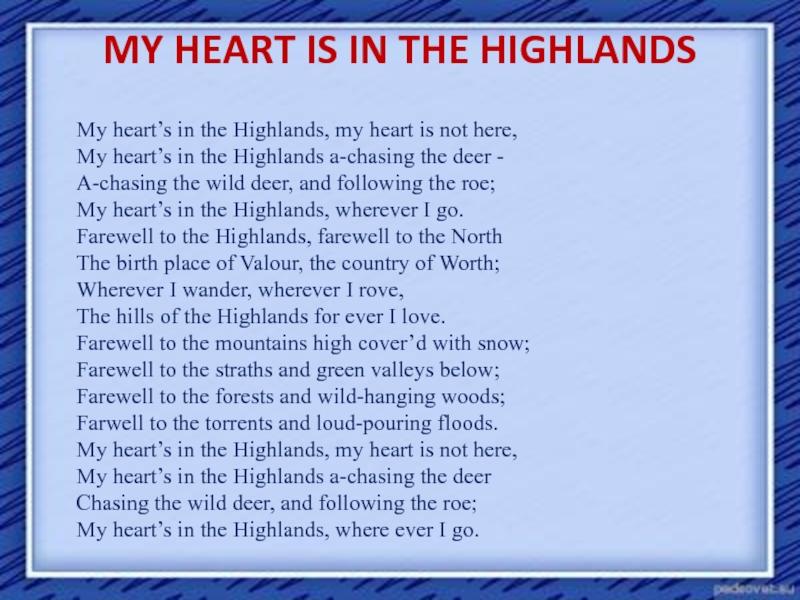
Слайд 6 Astana – is the capital of Kazakhstan.
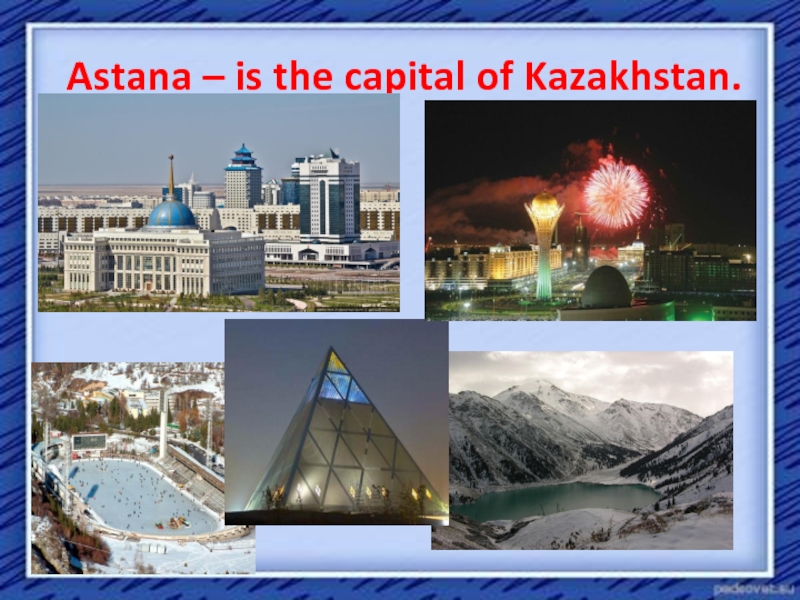
Слайд 8Typical Kazakhstan plants.
Blue Spruce
The blue Tian Shan
spruces are a true decoratiom of the Alatau mountains like candles , they rise upwards reaching heights of 40-50 metrs
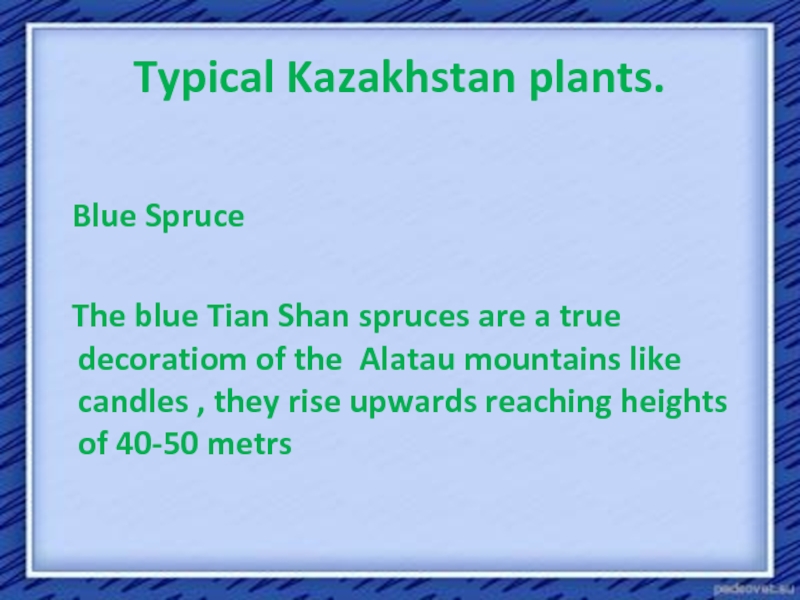
Слайд 10Tulips
Tulips — one of the most beloved and popular bands spring
flowering bulbs. Several thousand varieties, 15 classes and many new hybrid varieties of tulips, combines the advantages of different classes — are a great choice.
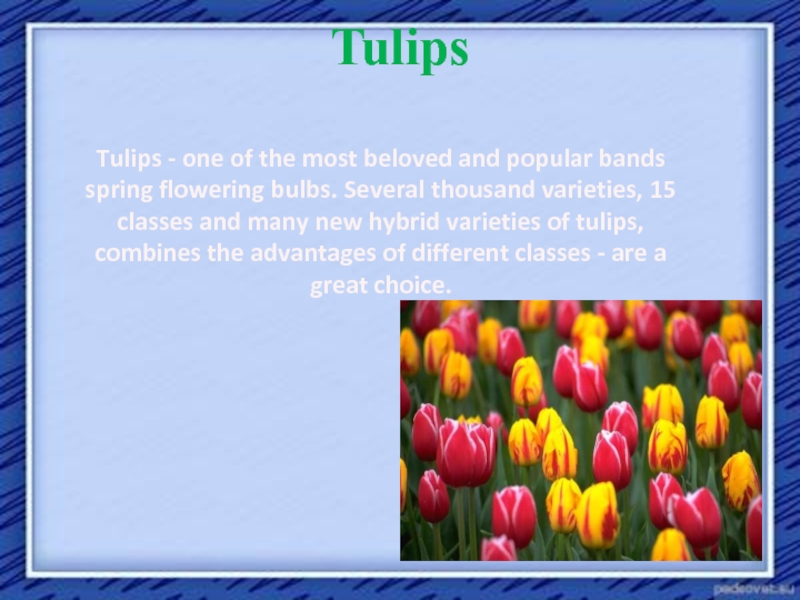
Слайд 11Rose
A rose is a woody perennial of the genus Rosa, within
the family Rosaceae. There are over 100 species. They form a group of plants that can be erect shrubs, climbing or trailing with stems that are often armed with sharp prickles.

Слайд 13Test
1. When was founded Astana (the former Akmola)?
A) in
1830 B) in 1930 C) in 1960
2. What is the name of the capital of Kazakhstan at present time?
A) Almaty B) Akmola C) Astana
3. Where was the Soviet Power established in March 1917?
A) in Astana B) in Akmola C) in Almaty
4. When has Astana became a new capital of Kazakhstan?
A) in 1999 B) in 1998 С) in 1997
5. On what river is Atana situated?
A) Ertis B) Ishim C) Zhaiyk
6. When was Astana awarded with the medal and title of City of Peace by UNESCO?
A) in 1999 B) in 1998 C) in 1997
7. What is the symbol of the Baiterek Tower?
A) peace and happiness B) freedom C) prosperity and happiness
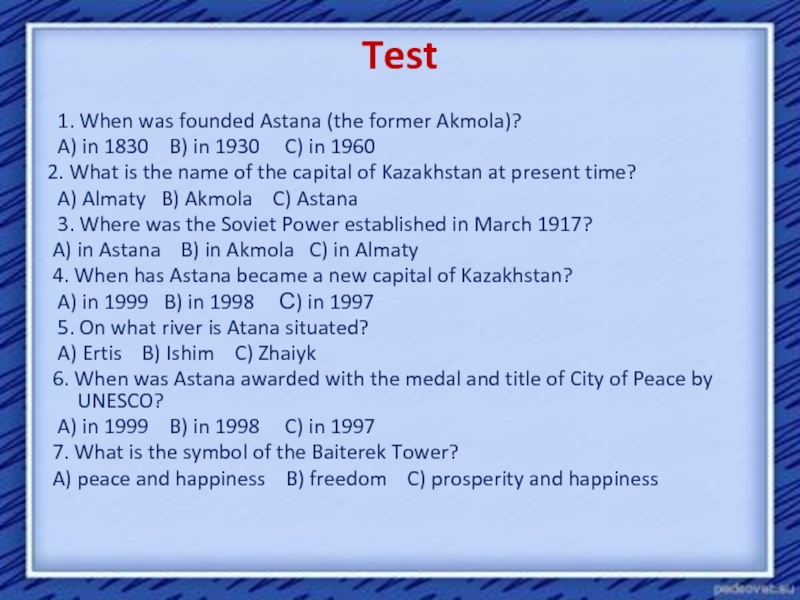
Слайд 14Home task
Retell the topic about of Kazakhstan
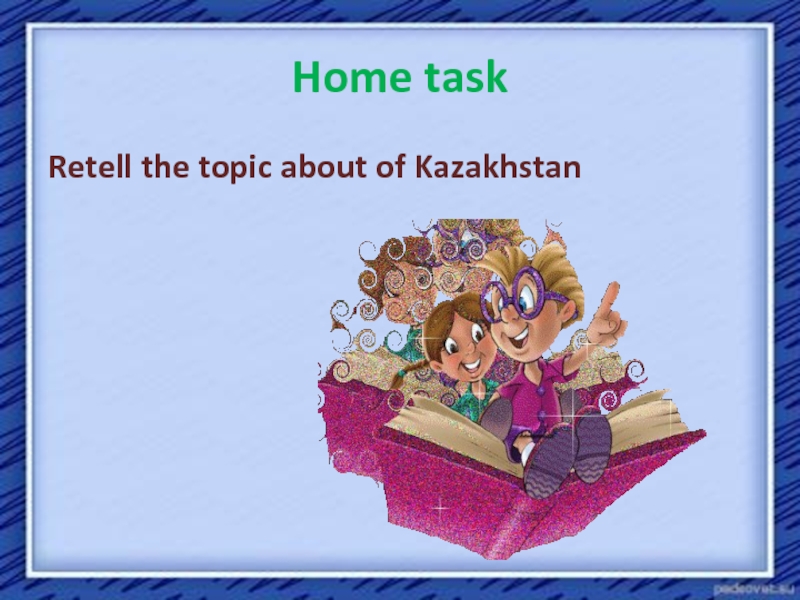
Слайд 4«Жаңа Ғасыр» № 175 гимназия
Ағылшын тілі пәні мұғалімі
Досқожаева Нұргүл Елшібекқызы
Ашық сабақтың тақырыбы:
«2011 — the Year of Kazakhstan’s 20th Anniversary as an Independent State «
Type of the lesson: Generalization and systematize the knowledge and method of activity
Aims: 1) Educational aim:
— To form intercultural-communicative skills in the frame of the sphere and theme;
— To develop students’ reading, listening and speaking skills;
— To activate their background knowledge in order to help them predict likely vocabulary in a given authentic text;
— To improve students’ own ability to organize discourse.
2) Development aim:
— To develop students’ critical thinking skills: — identifying central issues
— expressing problems clearly
— understanding cause and effect
— predicting consequences
— To develop perception, logic, imagination, and creativeness.
3) Upbringing:
— To be respectful to different cultures, to understand the meaning of different values of our country.
Objectives: To provide
— acquisition of the subject matter of professional communication on the basis of the studied speech material;
— met language skills;
— comprehension and adequate usage of the target language norms in free communication;
— ability and readiness to carry out discussion in the context of the theme;
— deepening of motivation and interest to the theme and to the future profession.
Materials: CD, Slide show, Presentation Microsoft Power Point, Quiz show, pictures, YOU TUBE Videos
Source: CD, dictionary, New Opportunities Intermediate (Macmillan), New Headway – Intermediate, Upper – Intermediate (Oxford), Mini – Dictionaries (Macmillan)
www.google.com – Chronicles of INDEPENDENT KAZAKHSTAN, YOU TUBE — KIWI

Слайд 5 Procedure of the lesson
Org. moment
Motivational-orientation stage:
Lead-in (making a
mind-map according to the theme, questions for brainstorming, studying the
definitions).
Warm up – Today we are going to talk about Independence of Kazakhstan. This lesson is a game – competition lesson. I am going to divide you into 2 groups “Argimak and Tulpar”. After each task you’ll get by one “asik”, it is your “point”. Be very attentive, because the winners will get a prize.
Check up home task
Task 1. At home you had to learn some new words by the theme Independence and find out their translations in Kazakh. Revision of the lexical material
Let’s revise the words we have studied at the previous lesson. Look at the slides and find the words with Kazakh translations.
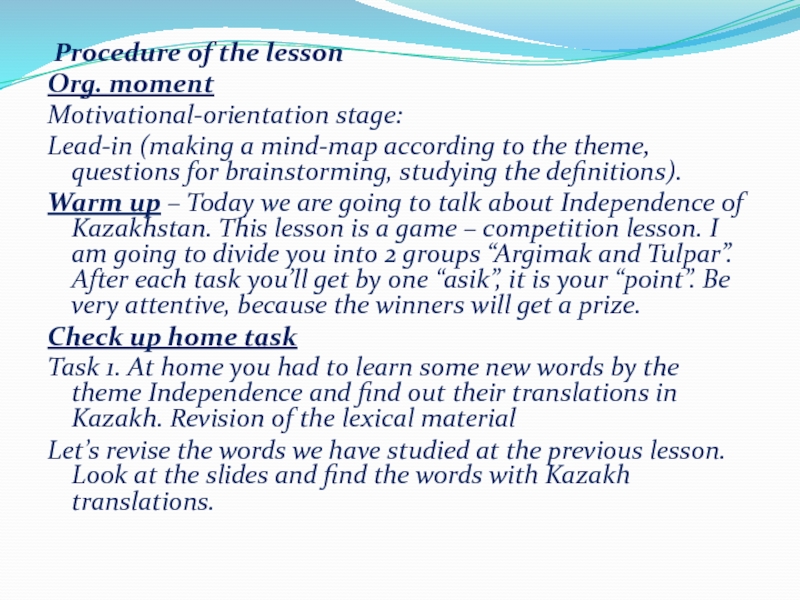
Слайд 6Something you want to achieve –
“ambition”
“жетістік”

Слайд 7The fact of being brave
“bravery”
«батылдылық»
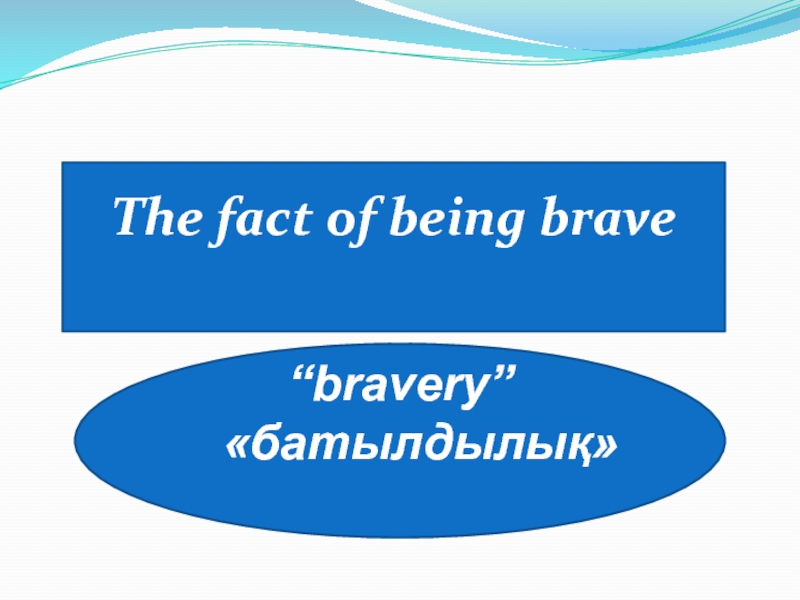
Слайд 8To grow or change into something, more successful, important bigger
etc.
“develop”
“өркендеу”

Слайд 9Something that is not easy to do –
“difficulty”
“қиындық”

Слайд 10To travel through an area to learn new information –
“explore”
“іздену”

Слайд 11To succeeded in doing something or getting what you want
–
“achieve”
“мақсатына жету”

Слайд 12A group, business, etc. that does thing together
“organization”
“ұйым”
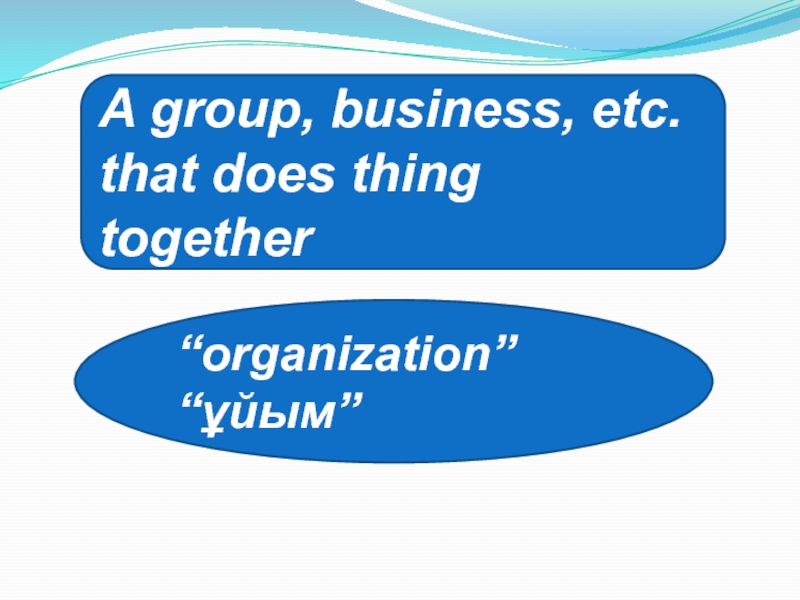
Слайд 13Something that is successful and has the result you wanted
—
“success”
“сәттілік”

Слайд 14Describes a country decision, etc. that is not controlled by
another –
“independence”
“тәуелсіздік”

Слайд 15That you can choose to do or not to do
–
“election”
“сайлау”
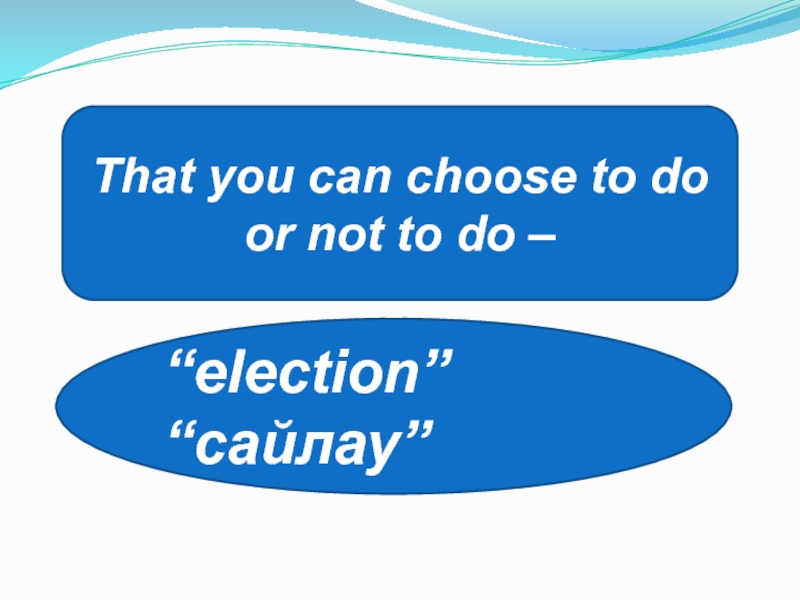
Слайд 16Allowed to exit or work without others controlling what it
does
“free”
“бостандық”
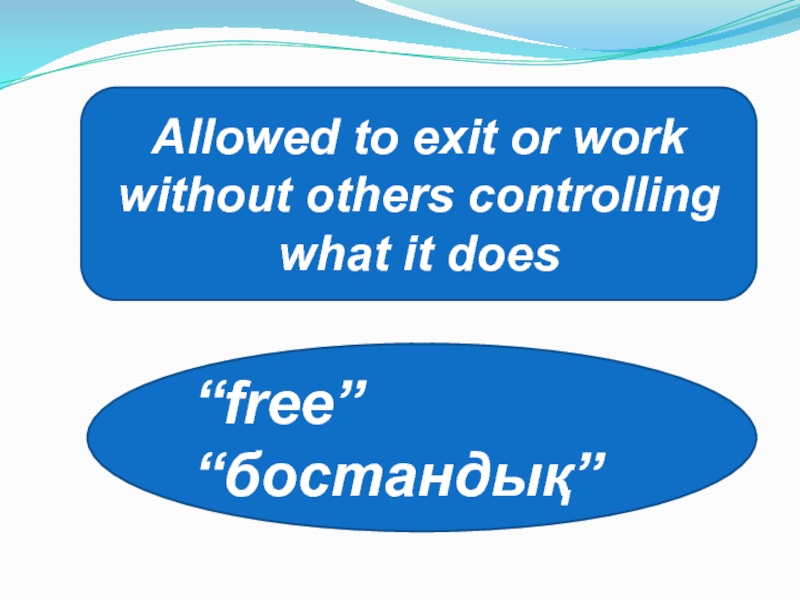
Слайд 17To make success or a special occasion by having a
party or by having fun –
“celebrate”
“мейрамдау”

Слайд 18According to the belief or behavior in a place or
of a group of people –
“traditionally”
“ұлттық”

Слайд 19The system of official rules about how all of us
must behave–
“law”
“заң”
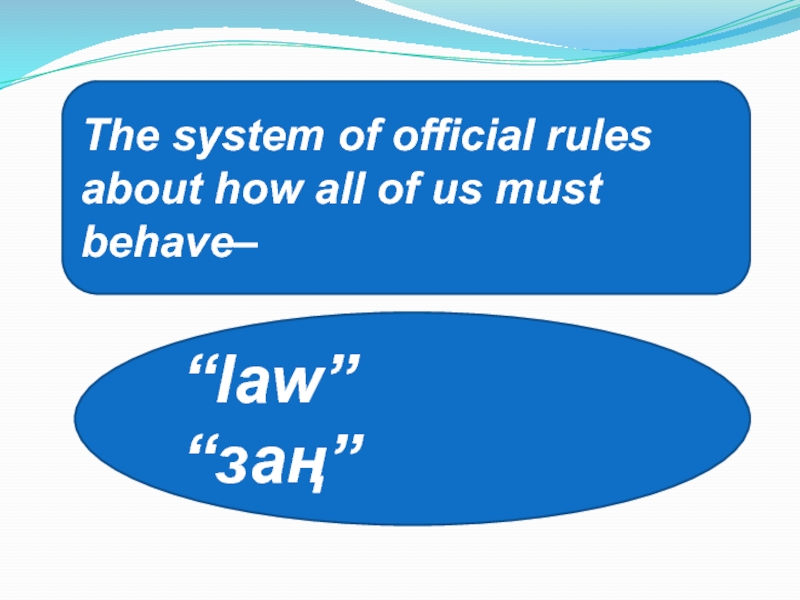
Слайд 20Consolidation: (Lexical material)
Now, let’s make word formation using these
words. Look at the table and complete it, for example:
if you take the word “ambition” – it is noun, let’s change it according to the table. There are 2 tables with key words. You will be given 5 minutes to complete the table.

Слайд 22ambition
ambitious
ambitiously
—-
difficulty
difficult
——-
——-
Development
———
——
develop
Achievement
———
——-
achieve
difficult
difficulty
——
———
explore
Explorer/ — ation
———
——-
——-
Organized/-ing
Organization/- er
———
successfully
success
successful
Succeed
election
electoral
———
elect
Celebration
——-
———-
celebrate

Слайд 23Next task is a puzzle. Listen to me carefully. I
will show the cards with Kazakh translation and you should
find the key word using the 1st and the 2nd letter of the each word
Puzzle

Слайд 24Тәуелсіздік
Independence
Тәуелсіз
Independent
Ұлттық
national
даму
develop
сайлау
election
тұлға
person
бостандық
freedom
жаңалықтар
news
құжат
document
бейбітшілік
peace
жетістік
Achievement
ғасыр
century
Ағылшын
English
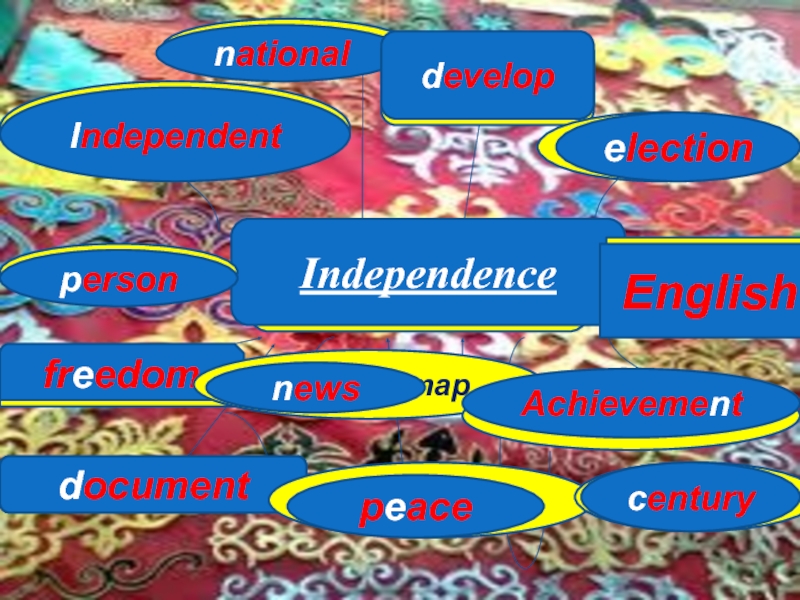
Слайд 26We are making the revision of our theme; you will
be given some questions connected with the Independence of our
country. Look at the questions and find the right answer.
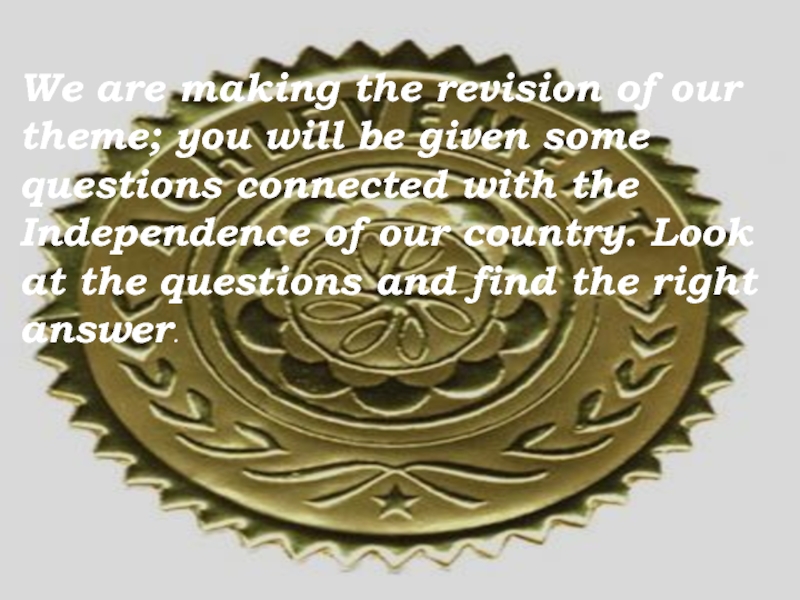
Слайд 27About Kazakhstan’s independence
Chronicles of INDEPENDENT KAZAKHSTAN
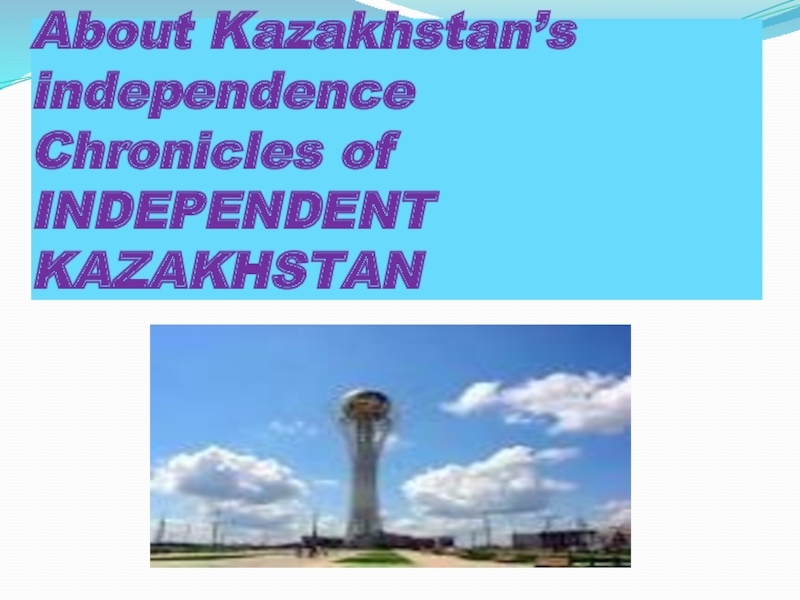
Слайд 291. When was the law passed on the independence of
Kazakhstan?
a. the 30th of August
b. the 1st of September
c. the
16th of December
The 16th of December

Слайд 30
2. When was the declaration adopted on Sovereignty Kazakhstan?
a. the
31st of January 1991
b. the 25th of October 1990
c. the
5th of October 1986
The 25th of October 1990
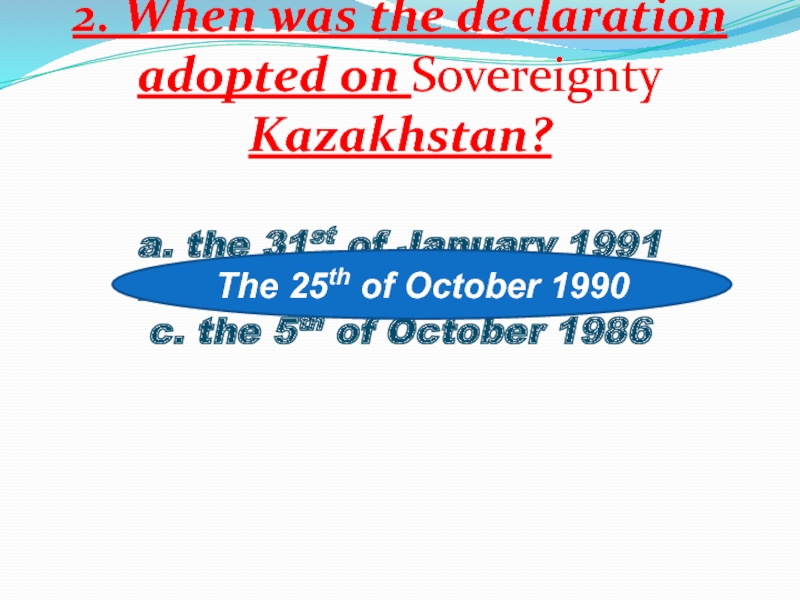
Слайд 31
3. When is the Ministry of Tourism
established?
A. the 12th
of August 1986
b. the 12th of August 1991
c. the 12th
of August 1997
The 12th of August 1991
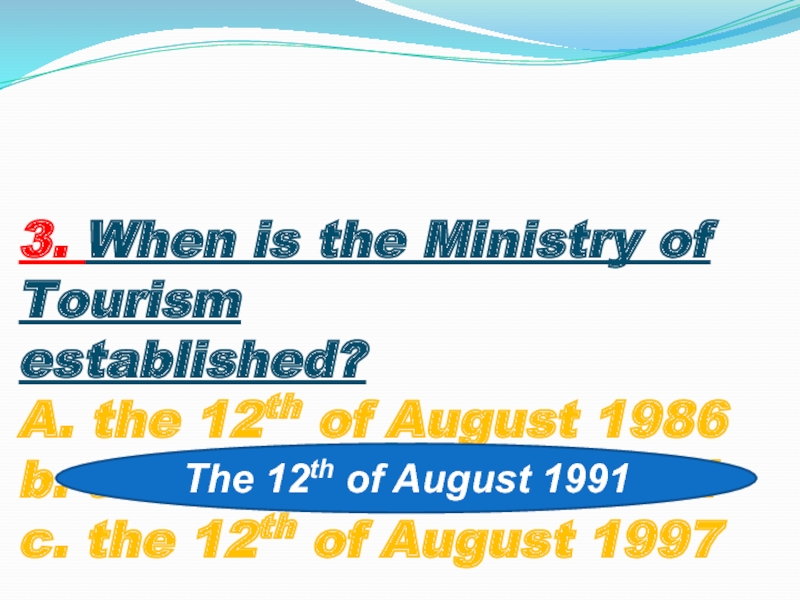
Слайд 324. When was the Semipalatinsk Nuclear test site closed?
A. 16th
of December 1991
b. 30th of August 1990
c. the 29th of
August 1991
The 29th of August 1991
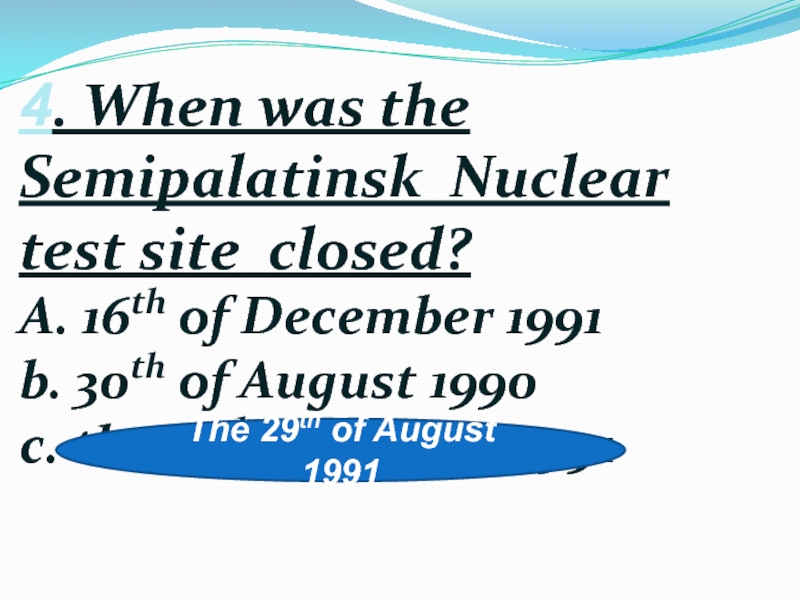
Слайд 335. When was Nursultan Nazarbayev elected?
a. The 16th of December
1991
b. the 1st of December 1991
c. the 30th of December
1991
The 1st of December 1991

Слайд 346. When did Kazakhstan become a member of the OSCE?
a.
The 2nd of October 1995
b. the 2nd of January 1992
c.
the 4th of January 1992
The 2nd of January 1992
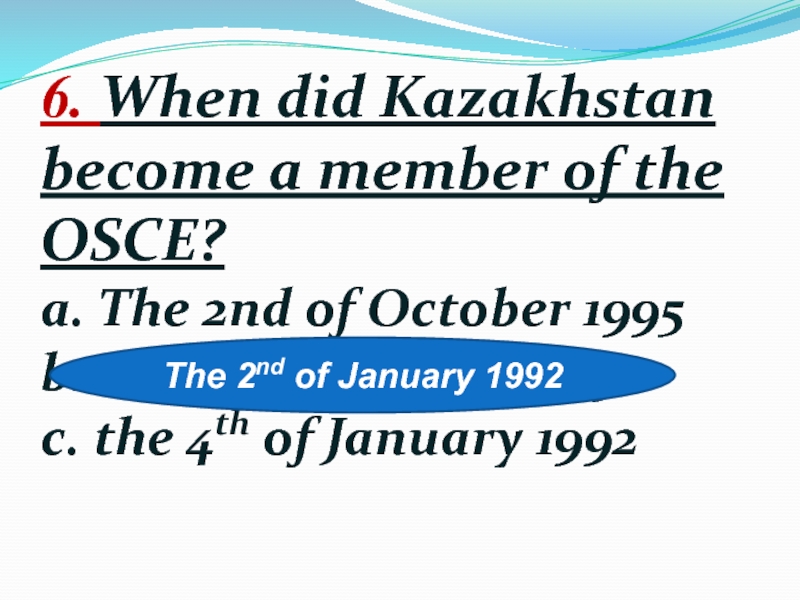
Слайд 357. When did Kazakhstan become a member of the UN?
A.
The 3rd of March 1992
b. The 3rd of March 1998
c.
The 3rd of March 1998
The 3rd of March 1992
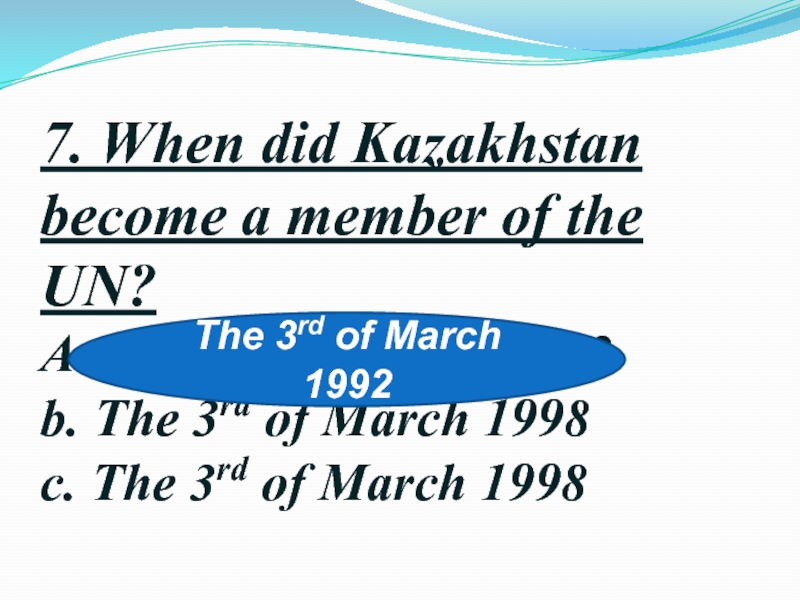
Слайд 368. When was the Laws on the national flag, national
emblem and national anthem adopted?
A. the 4th of June 1992
b.
the 16th of June 1992
c. the 4th of June 1995
The 4th of June
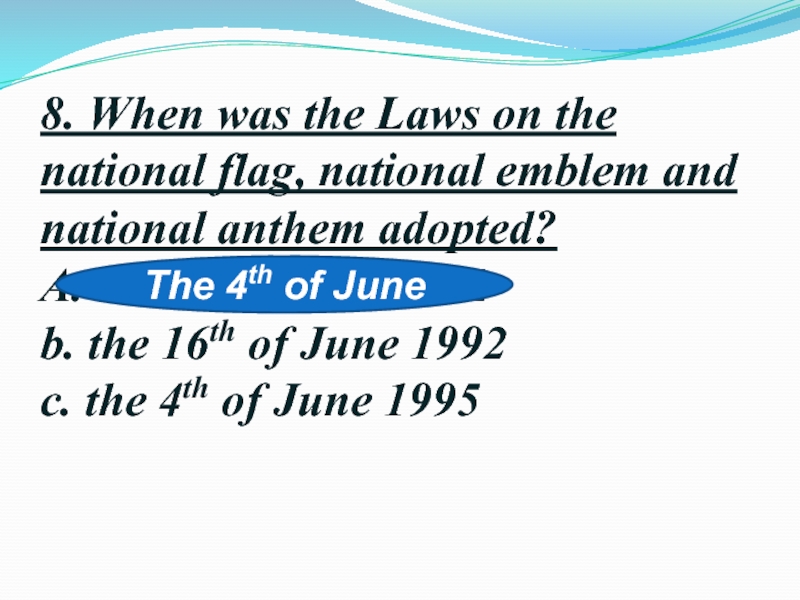
Слайд 379. What was established on the 18th of September 1992?
A.
The first national TV and radio broadcasting company
b. The
first hospital
c. The first school in Astana
The first national TV and Radio Broadcasting company
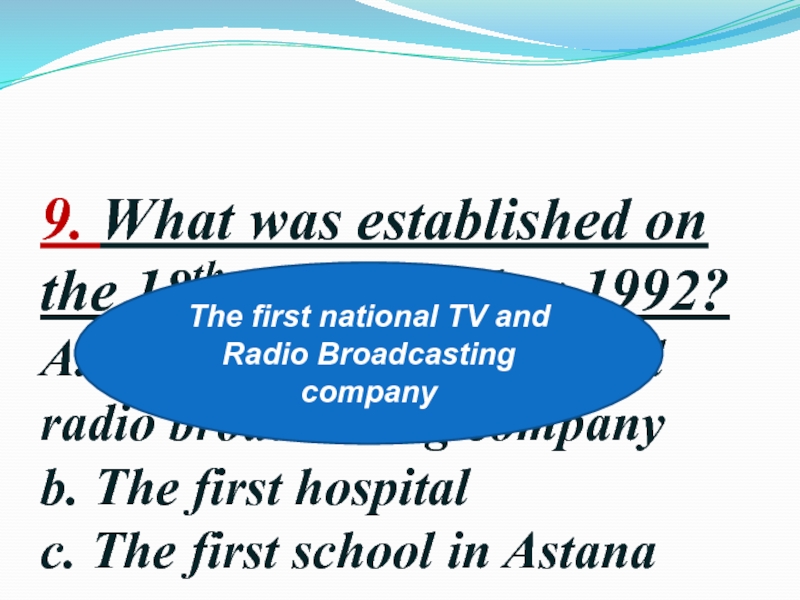
Слайд 38
10. When was a new Constitution adopted?
A. the 16th of
December 1991
b. the 30th of August 1997
c. the 30th
August 1995
The 30th of August
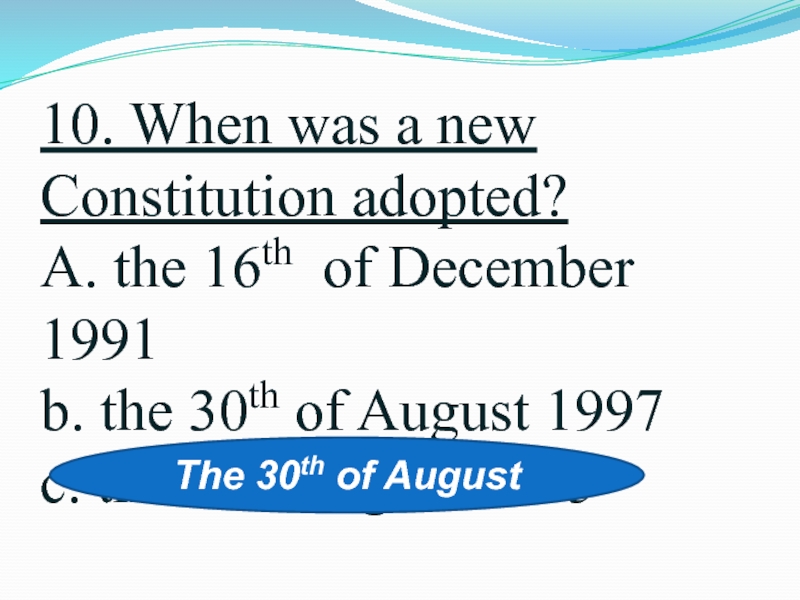
Слайд 3911. When did Astana become a capital of Kazakhstan?
a. The
30th of August 1995
b. the 15th of September 1995
c. the
15th of September 2001
The 15th of September 1995
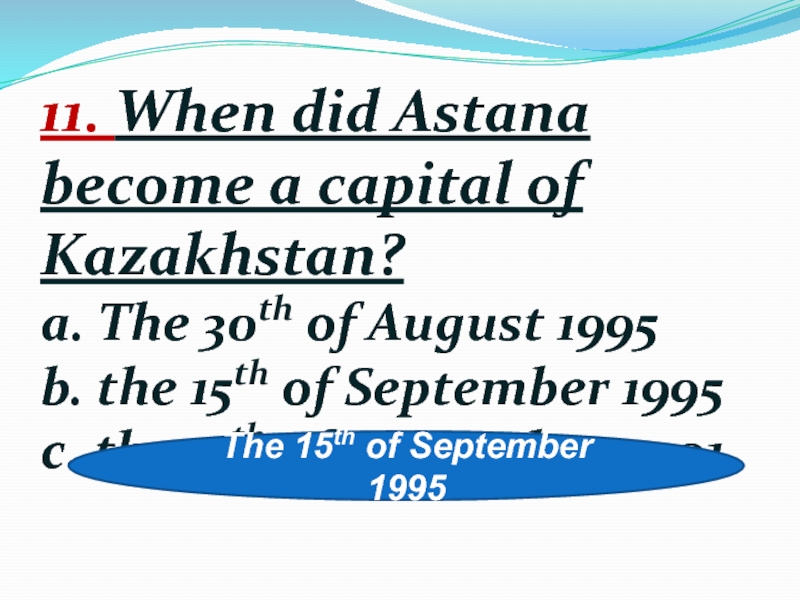
Слайд 41Let’s check your knowledge about geography and history, are you
good at it?
We will watch some extracts and you should
find which country is it and when they celebrate their Independence.

Слайд 43
The United States of
America
July 4, 1776
Washington is the
capital of the USA

Слайд 45 Korea
August 15,1945
Seoul — Capital of Korea
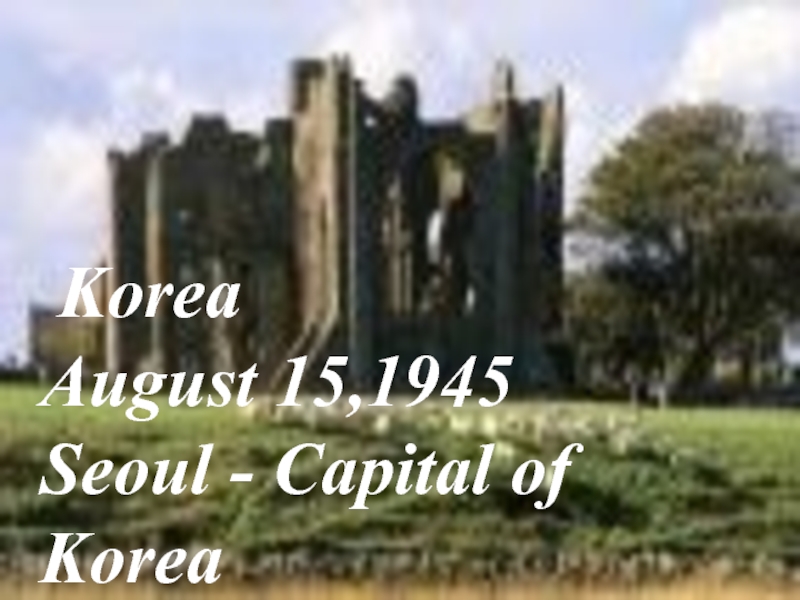
Слайд 50
Argentina
July 9, 1816
The capital of Argentina is Buenos Aires
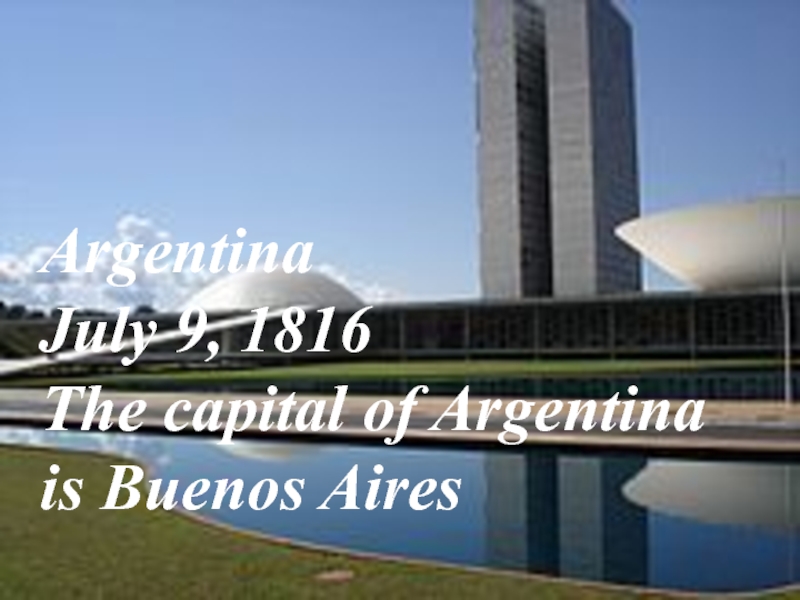
Слайд 657. Evaluation
Reflex ion:
Teacher’s concluding talk: Dear students and teachers! Our
lesson has just finished. All the pupils worked hard and
they showed their best knowledge. Thank you for coming and taking an active part in our open lesson. For today’s work everyone got an excellent mark. However, let’s count your “asik — points” So, who is winning? Thank you for everyone.
8 Home task: Writing. Write a composition about your Motherland

Слайд 66 Назар аударғандарыңызға рахмет!

